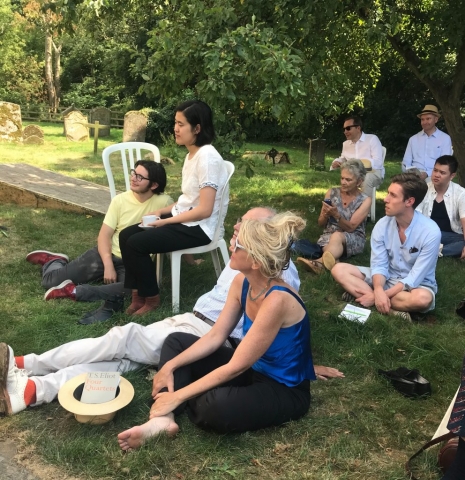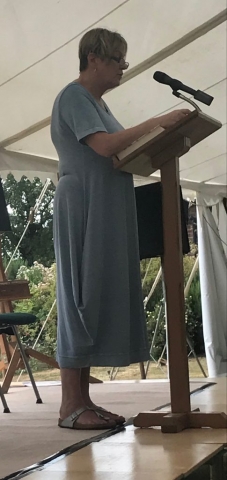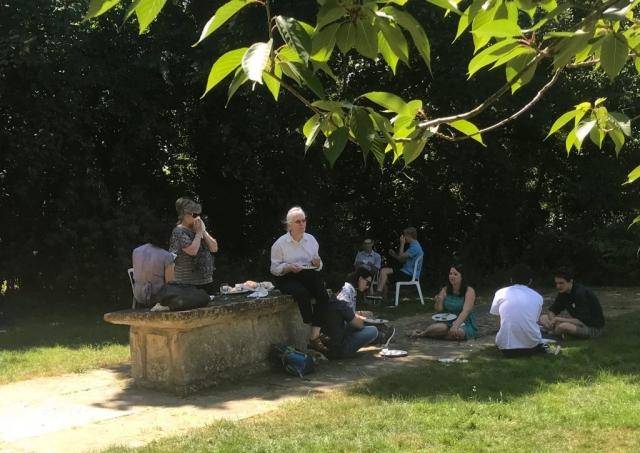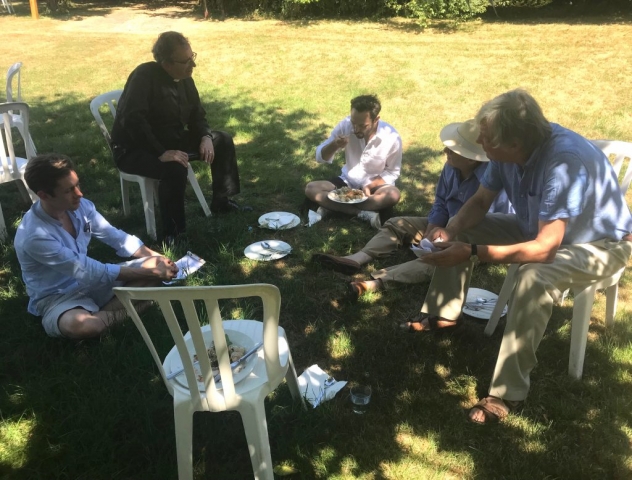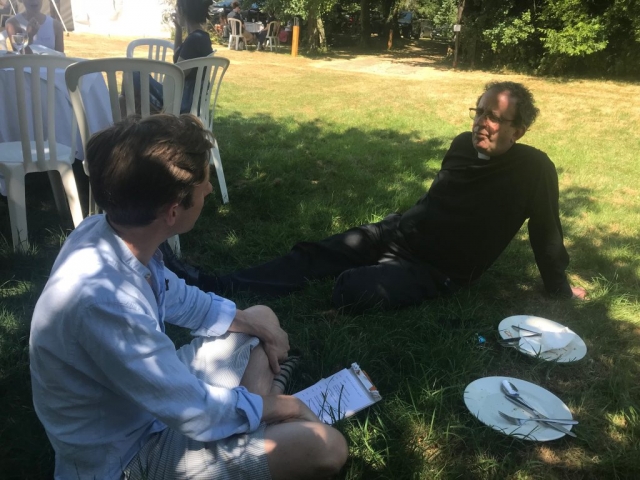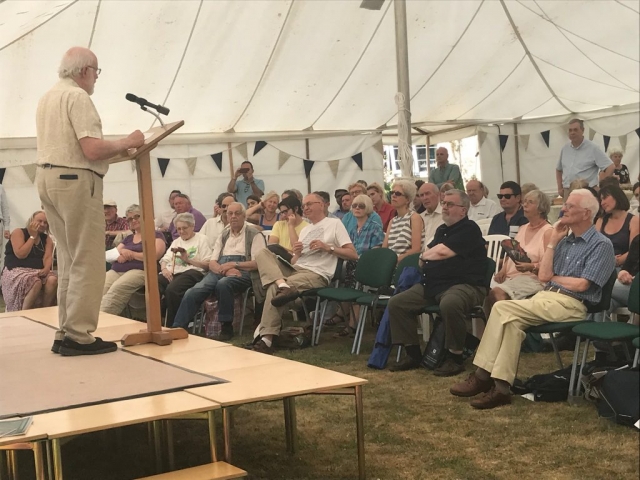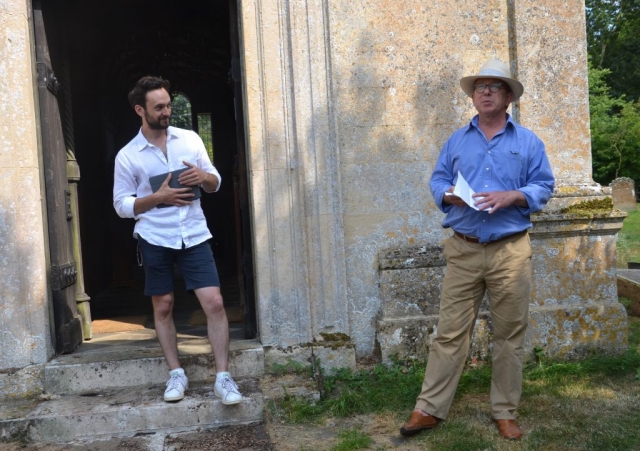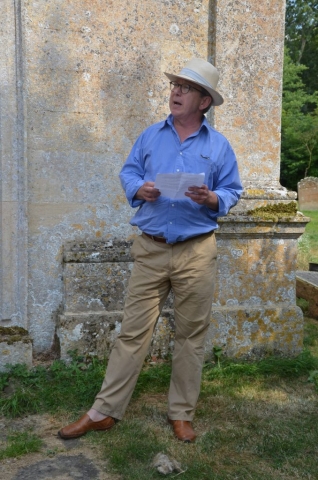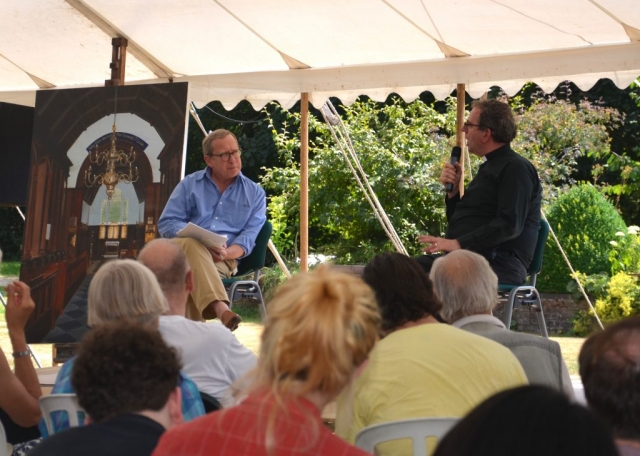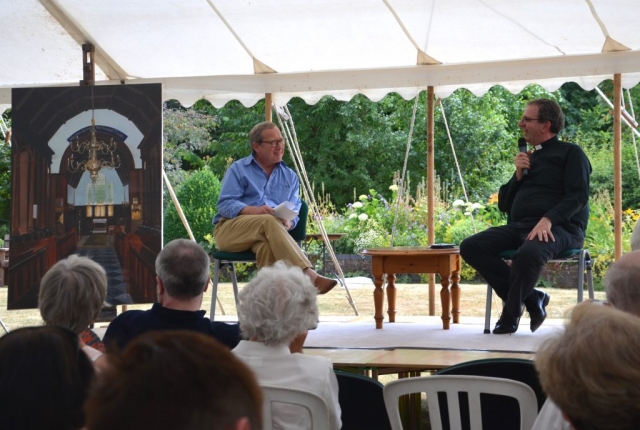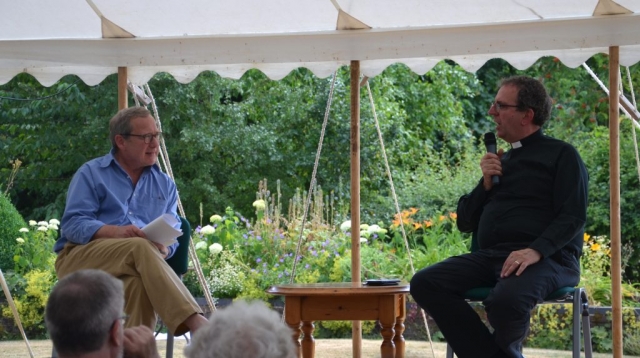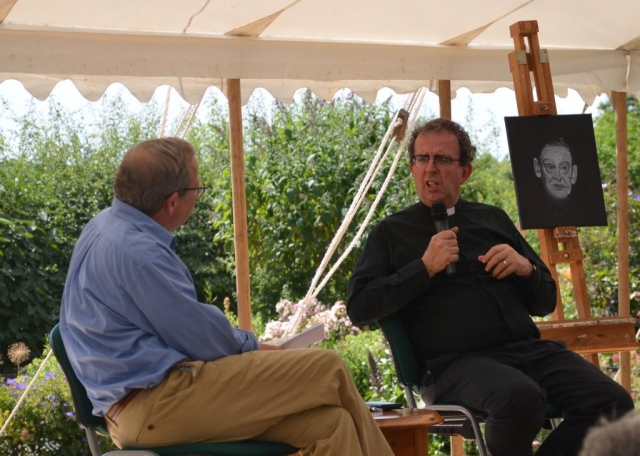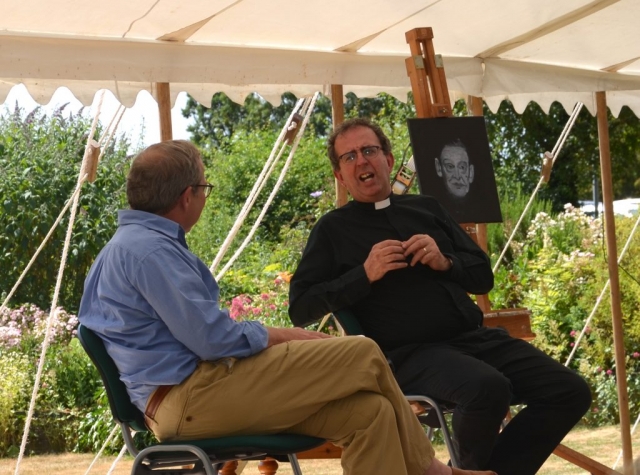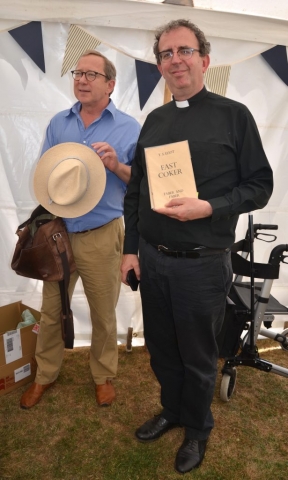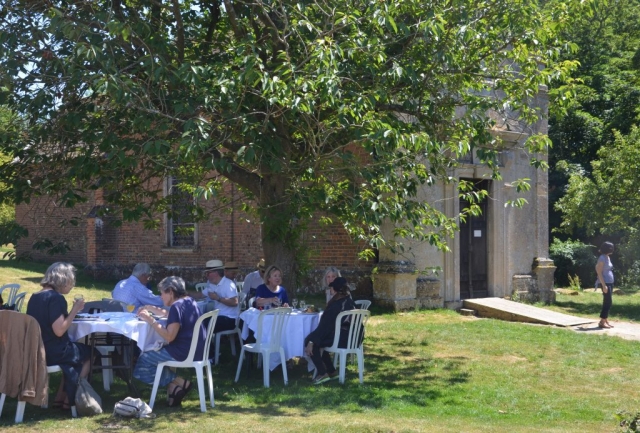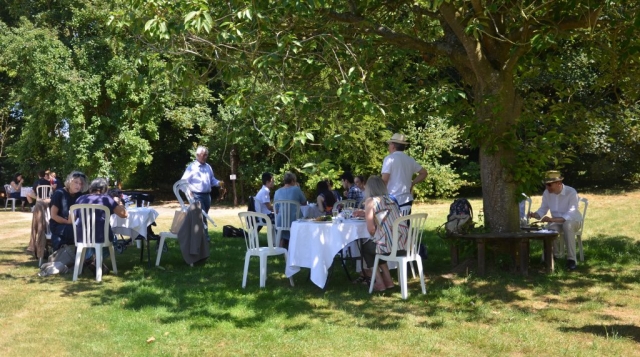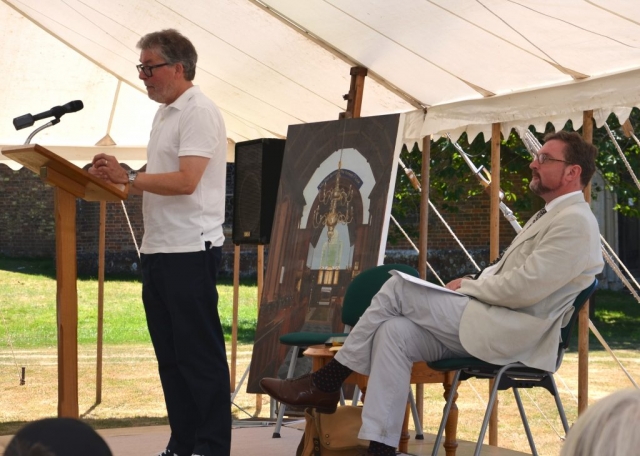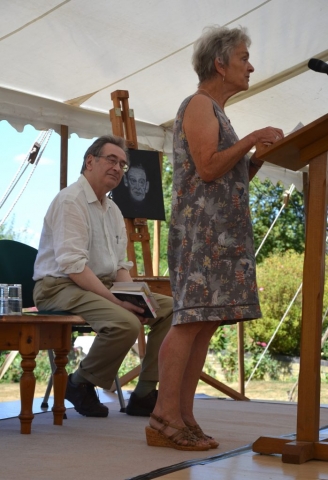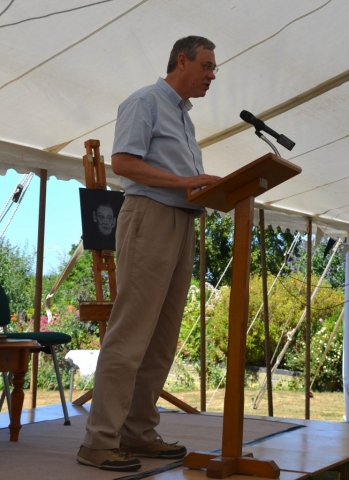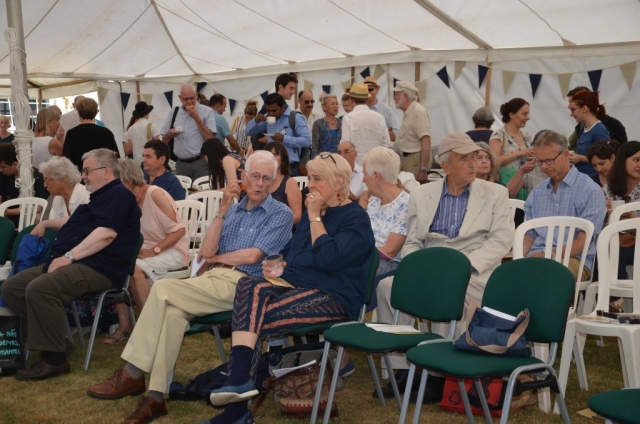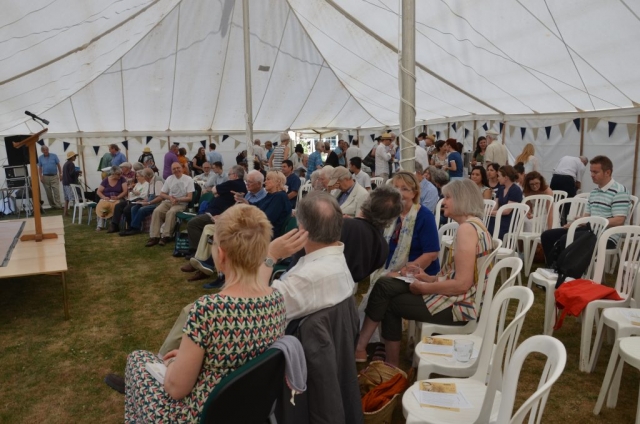The Structure of Bristol Surprise Major
Some 18 months ago, I described learning Bristol Surprise Major. I haven’t rung very much of it since then, but I want to look at its structure – what the different bells are doing and how it fits together. Because it’s really very simple, and can be described in a few short sentences:
- The treble always treble bobs, out to the back, and then back down to the front, over and over again.
- The other bells work together, either as a group on the front four, or as a group on the back four, and from time to time a bell moves from the front group to the back group, or vice versa.
So far so good, now for the clever part: - All the bells in the group that contains the treble simply treble-bob inside that group, in phase with the treble, up and down or down and up, until the treble crosses to the other group.
- The four bells in the other group (the one without the treble) just plain hunt; and every time the treble (which is in the other group) moves from one dodging position to another, the four plain-hunting bells switch from hunting “right” (where “leading” and “lying” are made at hand and back) to hunting “wrong” (where “leading” and “lying” are made at back and hand) or vice versa. See below for an explanation of moving from one dodging position to another and of “leading” and “lying”.
- There are three occasions when a bell, other than the treble, passes from one group to the other.
- When the treble itself moves from one group to the other, a bell from the other group must move in the opposite direction;
- When the treble leads or lies, the two bells that are in 4–5 swap places.
And that’s it. Now you understand how Bristol Surprise Major works.
Before moving on, an explanation or clarification of the words moving from one dodging position to another. The treble dodges 1–2 up, and then moves to dodge 3–4 up, and then to dodge 5–6 up. The four strokes when it is in 3–4 are one dodging position, and the four strokes when it is in 5–6 are the next dodging position. The point at which the treble moves from one dodging position to the next is called a cross-section.
At the lead-end and the half-lead, the method is symmetric as the treble leads or lies at the back, and so the plain-hunting bells do not change direction. The treble is considered to be in the same dodging position (1–2) all the time that it is dodging 1–2 down, leading, and dodging 1–2 up at the front, and similarly in the 7–8 dodging position all the time that it is dodging 7–8 up, lying, and dodging 7–8 down at the back. Expressing that slightly differently, at the front and back, the treble spends eight strokes in the same dodging position: eight strokes in 1–2 (when it is dodging 1–2 down, leading, and dodging 1–2 up); and eight strokes in 7–8 (when it is dodging 7–8 up, lying, and dodging 7–8 down). So when the treble is at the front or the back, the bells that are respectively at the back or the front all plain hunt for eight blows before changing direction. We’ll see this more clearly when we trace out the work of each bell.
It’s also worth noting that “leading” and “lying” are in quotation marks, because this term here includes leading and lying within each group of four. So if while plain hunting you are making two blows in fourth place this is included in “lying” because you are lying at the back of your group of four; and similarly if while plain hunting you are making two blows in fifth place this is included in “leading” because you are leading your group of four.
With that introduction, we can look at how the bells interact with each other and with the treble.
1 CommentT S Eliot Festival 2018
This year’s T S Eliot Festival at Little Gidding was held on Sunday 8 July 2018. Here is a selection of pictures by Carry Akroyd.
0 CommentsCentenary of the WW1 Armistice
Over the last few years the Church of England has published various liturgical resources for commemorating the centenary of significant moments in the First World War.
It has now added to that collection a set of resources for the centenary of the Armistice on 11 November, and entitled ‘Steps towards Reconciliation’: a monologue interspersed with words and music.
How are we to mark the end of a War in which so many lives were lost and damaged? We will certainly remember, but we must also commit ourselves afresh to working together for peace. Reconciliation requires an honest ‘truth telling’, and the text that follows seeks to respect the fact that we may only be able to take steps towards that goal.
This is an imaginative and thoughtful resource that can be used in a number of settings on and around 11 November 2018. It has been compiled by members of the Liturgical Commission.
The text is available as a pdf file here.
1 CommentTowards a Safer Church: Liturgical Resources
On Friday, the Liturgical Commission of the Church of England published “safeguarding resources, for use in churches across the country, including Bible readings, prayers and suggested hymns, chosen in consultation with survivors” under the title Towards a Safer Church: Liturgical Resources.
There is a press release here, and the liturgical resources are available in PDF format here
The Chair of the Liturgical Commission, Robert Atwell, Bishop of Exeter, in an introduction to the resources has written:
The Church needs to be at the vanguard of fostering a change of culture across society. Safeguarding is at the forefront of public consciousness and the Church needs to embody best practice in safeguarding in our network of parishes, schools and chaplaincies as part of our commitment to excellence in pastoral care.
Many of these resources are already being used widely across our churches, but we thought it would be helpful to gather them into one place for ease of access. Collectively they are neither the first word nor the last word on this subject, but they are offered in the hope that by God’s grace the Church may become a safer place where everyone is valued.
Libby Lane, Bishop of Stockport, has also written about the resources here
The resources have been compiled by the Liturgical Commission and staff, in consultation with survivors, who have themselves suggested some of the resources, with the aim providing prayers and other resources for various occasions. This includes use with survivors and others directly affected, as well as events such as the commissioning of safeguarding officers in parishes and dioceses. Most of the material had been previously published (including commended and authorized liturgical texts), but it has been brought together in one place so that it is easier to find and to use.
(This item has also been posted on the main Thinking Anglicans page.)
0 CommentsThinking about Yorkshire and Pudsey Surprise
I looked recently at the underlying structure of Cambridge Surprise on any number of bells (6 or more), and now I want to do the same with Yorkshire and Pudsey Surprise on any number (8 or more, since they are false on 6 bells, though still ringable as Yorkshire/Pudsey Block Delight Minor). This may well not directly help you to ring these methods, especially if you are just learning them. But understanding the structure of a method helps you know why you’re doing what you are doing, and what other bells are doing around you.
You might think Pudsey is a slightly odd choice to include immediately after Cambridge, but there’s a good reason why. In many ways it is the complement of Yorkshire: the changes each of these methods make, compared with Cambridge, are essentially identical except that they are made in different places.
The basic idea of Yorkshire and Pudsey is similar to Cambridge: the treble always treble-bob hunts in each dodging position (1–2, 3–4, 5–6, 7–8, etc); and wherever possible the other bells treble-bob hunt, but out of phase with the treble.
(See the article on Cambridge structure for a reminder of what it means to treble-bob hunt either in phase or out of phase with the treble.)
But Yorkshire and Pudsey each make one additional change to Cambridge. In each of them there is one bell that treble-bob hunts in phase with and adjacent to the treble, and the other bells have to deal with that bell as well as with the treble. The two methods differ only in which bell is in phase with the treble, and therefore in which places the extra adjustments must be made.
In Pudsey, it is the 3rd-place bell, which treble-bobs up to the back, dodging down with the treble and making places under the treble at the half-lead, and then dodging up with the treble and back down. Except when dodging with the treble at the back it is always one dodging position higher than the treble.
In Yorkshire, conversely, a bell treble-bobs down to the front, dodges up with the treble and makes 2nds place, and then dodges down with the treble and treble bobs out to the back. This bell treble bobs one dodging position lower than the treble. Whereas in Pudsey the work begins and ends when the treble is at the front, in Yorkshire it begins and ends when the treble is at the back, i.e. from the half-lead to the next half lead, and begins as the work of the 5th-place bell, which becomes the 2nd-place bell at the lead-end in the middle of this piece of work.
| Yorkshire | Pudsey | |||
| half-lead end | -----5-1 |
1-3----- |
lead end | |
----5-1- |
-1-3---- |
|||
-----5-1 |
1-3----- |
|||
----5-1- |
-1-3---- |
|||
| treble-bobs down to the front | ---5-1-- |
--1-3--- |
treble-bobs out to the back | |
--5-1--- |
---1-3-- |
|||
---5-1-- |
--1-3--- |
|||
--5-1--- |
---1-3-- |
|||
-5-1---- |
----1-3- |
|||
5-1----- |
-----1-3 |
|||
-5-1---- |
----1-3- |
|||
5-1----- |
-----1-3 |
|||
51------ |
------13 |
|||
15------ |
------31 |
|||
| where it dodges with the treble | 51------ |
------13 |
where it dodges with the treble | |
15------ |
------31 |
|||
| makes 2nd place over the treble | 12------ |
------31 |
makes (n‑1)th place under the treble | |
21------ |
------13 |
|||
| and dodges down with the treble | 12------ |
------31 |
and dodges up with the treble | |
21------ |
------13 |
|||
2-1----- |
-----1-3 |
|||
| and treble bobs out | -2-1---- |
----1-3- |
and treble bobs down | |
2-1----- |
-----1-3 |
|||
-2-1---- |
----1-3- |
|||
--2-1--- |
---1-3-- |
|||
---2-1-- |
--1-3--- |
|||
--2-1--- |
---1-3-- |
|||
---2-1-- |
--1-3--- |
|||
----2-1- |
-1-3---- |
|||
-----2-1 |
1-3----- |
|||
----2-1- |
-1-3---- |
|||
-----2-1 |
1-3----- |
|||
----2--1 |
1--3---- |
These two pieces of work are mirror images of each other.
Next, let’s consider one small but important point. In Yorkshire, the bell treble-bobbing in phase with the treble is below the treble. The other bells must change their behaviour (compared with Cambridge) whenever they meet this bell, and by definition that can only happen below the treble, since that’s where this in-phase treble bobbing happens. Whenever a bell is above the treble it behaves in exactly the same fashion as it would in Cambridge. That’s why Yorkshire is “Cambridge above the treble”.
In Pudsey, on the other hand, the bell treble-bobbing in-phase with the treble is above the treble. The other bells must adjust their behaviour when they meet this bell above the treble, so the changes from Cambridge occur above the treble, but below the treble Pudsey is the same as Cambridge.
Now let’s turn to the other bells. They are trying to treble-bob out of phase, so when they encounter these two bells (the treble and the bell in-phase with the treble) then they must adapt their work.
Because the two bells are in adjacent positions, we will dodge with one and plain hunt past the other, though which of these comes first depends on where we meet them. And in addition, we must also make places adjacent to the dodge to switch phase.
There are two possibilities.
We can either plain hunt past a bell, dodge with the other, and then make places and (now back out of phase) dodge again. Or else we do the opposite of this: after dodging out of phase, we make places to get in phase, dodge with one of the in-phase bells and then plain hunt past the other.
Which we do depends on whether we have already dodged when we meet the first of the two bells.
If we meet the first of the two bells after we have dodged, then they have not yet dodged, so we must make places to wait for them, dodge, and then pass through the next dodging position to get back out of phase, and then resume out-of-phase treble bobbing. (In the following diagrams the treble and the in-phase bell are labelled p and q; in Pudsey p is the treble and q the in-phase bell; in Yorkshire p is the in-phase bell and q is the treble.)
| when going down to the front |
when going out to the back |
||
p-q--x-- |
--x--p-q |
||
-p-qx--- |
---xp-q- |
||
p-q-x--- |
---x-p-q |
||
-p-q-x-- |
--x-p-q- |
||
--p-qx-- |
--xp-q-- |
||
---pxq-- |
--pxq--- |
||
--p-qx-- |
--xp-q-- |
||
---pxq-- |
--pxq--- |
||
---xp-q- |
-p-qx--- |
||
--x--p-q |
p-q--x-- |
||
-x--p-q- |
-p-q--x- |
||
x----p-q |
p-q----x |
||
-x----pq |
pq----x- |
||
x-----qp |
qp-----x |
||
| Alternatively, if we meet the two bells before we have dodged, then they have already dodged and one of them is about to come into our current position so we must miss a dodge and go straight on to dodge with the other one, and having done so, make places to get back out of phase and resume out-of-phase treble-bobbing: | |||
p-q--x-- |
--x--p-q |
||
-p-qx--- |
---xp-q- |
||
--pxq--- |
---pxq-- |
||
--xp-q-- |
--p-qx-- |
||
--pxq--- |
---pxq-- |
||
--xp-q-- |
--p-qx-- |
||
--x-p-q- |
-p-q-x-- |
||
---x-p-q |
p-q-x--- |
||
---xp-q- |
-p-qx--- |
||
--x--p-q |
p-q--x-- |
||
---x--pq |
pq--x--- |
||
--x---qp |
qp---x-- |
||
There’s one more detail before we have enough information to understand each of these methods. If we are about to meet the treble or in-phase bell at the back, when we are in the topmost dodging position, then rather than missing a dodge or making places to get in phase we add an extra dodge. We’ve already seen this in Cambridge when we were about to meet the treble and we were at the back. Yorkshire here is identical to Cambridge (because we are above the treble), but in Pudsey this also applies when meeting the in-phase bell, so we must do these double dodges when about to meet that bell. And because the method is symmetrical, when we said “about to meet”, the same applies when “reaching the back having just met”, as it does in Cambridge.
In the full article, we’ll look at the details of Yorkshire, then at Pudsey, and then do a final comparison of the two methods.
0 CommentsThinking about Yorkshire Surprise
I looked recently at the underlying structure of Cambridge Surprise on any number of bells (6 or more), and now I want to do the same with Yorkshire Surprise on any number (8 or more, since it is false on 6 bells).
The basic idea of Yorkshire is similar to Cambridge: the treble always treble-bob hunts in each dodging position (1–2, 3–4, 5–6, 7–8, etc), and wherever possible the other bells treble-bob hunt, but out of phase with the treble.
(See the article on Cambridge structure for a reminder of what it means to treble-bob hunt either in phase or out of phase with the treble.)
In Yorkshire there is an exception to this out-of-phase treble bobbing: starting when the treble is dodging at the back, one of the bells treble-bobs in phase with the treble and one dodging position below it, making 2nd place over the treble at the lead-end, and continuing in phase until the treble reaches the back again.
Everything else in Yorkshire is a consequence of this change from Cambridge.
The bell that starts doing this in-phase treble bobbing is the 5th-place bell, from the half-lead when it has passed the treble at the back, and continuing as the 2nd-place bell until the half-lead as it approaches the back. For brevity, I call this piece of work the in-phase bell, because it is treble-bob hunting in phase with the treble. (This isn’t a shorthand I have come across elsewhere, but it is a convenient term.)
Because the treble and the in-phase bell are in adjacent dodging positions, the other bells meet the in-phase bell immediately before or immediately after meeting the treble, They must either pass it or dodge with it, just as they do with the treble.
Remember that in Cambridge places a bell dodges with the treble in the middle of the work, making places either side of that dodge in order first to get in phase with the treble, and then to get back out of phase. But in Yorkshire there is immediately another in-phase bell to deal with: so if we have dodged with the treble we must curtail Cambridge places to pass the in-phase bell. Or alternatively, if it’s the treble that is passed, then we must dodge with the in-phase bell and make places to change phase. This changes Cambridge places into Yorkshire places and also adds them in positions where in Cambridge you just plain hunt past the treble.
Let’s see what that means in practice.
0 CommentsLooking at Cambridge Surprise (again)
I’ve been ringing Cambridge Surprise for quite a few years now. I began with Minor (in 2005), learning the various pieces of work by rote. Then when I could do that I moved on to Major (in 2006), again, learning by rote the bits that were different from Minor. Then I got to the point that I could barely remember how to ring Minor, because I always forgot which bits of Major to leave out. I’ve got over that too, and recently have begun to ring Minor a bit more, because we have ringers who have moved on to learning it.
All of which sparked an interest in learning Cambridge Surprise Royal, i.e. on 10 bells. (Ringing it would be a rather different matter as I’m not a ten-bell ringer, and although I have rung Caters a handful of times, I’ve never rung Royal. But I want to stick with the theory for a bit.)
So I looked up the blue line for Cambridge Surprise Royal, and in searching for it I came instead across descriptions of Cambridge, and I realized I had been missing something about Cambridge all these years. The sort of thing that makes me wonder whether I could have learnt the method in a much better way — rather than learning sections by rote, and then re-learning it by place bells, instead learning it and ringing it from first principles. Because the principle behind Cambridge, on any number of bells, is quite simple.
Here it is:
- the treble always treble-bob hunts from the front, out to the back where it lies behind and then treble-bob hunts down to the front again; and it does this over and over again, (n‑1) times in a plain course, where n is the number of bells (6 for Minor, 8 for Major, 10 for Royal, etc).
- each of the other bells also treble-bob hunts, but it does so “out of phase” with the treble. This means that whenever it meets the treble, it must change its pattern of treble-bob hunting to fit around the treble.
What do we mean by treble-bob hunting “out of phase”, and what are the consequences of this?
1 Commentlearning London Surprise Major
Having more or less successfully rung a Plain course of Bristol Surprise Major last weekend, it’s time — like Dick Whittington — to turn to London: London Surprise Major, that is. London is the last of the “standard eight” Surprise Major methods, and Coleman describes it as the zenith of standard surprise. But he also suggests that it is easier to learn than Bristol, and strongly recommends learning it by place bells. Other London web pages seem to agree, one suggesting learning pairs of place bells together, as in each pair one is the mirror of the other.
The order of the place bells is the same as for Rutland and Bristol: 2, 3, 5, 7, 8, 6, 4; with the pairs being: 2 and 4, 3 and 6, and 5 and 8; while 7 is symmetric about the half-lead end.
There are a few familiar pieces of work:
- Stedman whole turn, which occurs only on the front
- fishtails, which occur at the back (8–7‑8), and also both ways in 5–6 — 6–5‑6 and 5–6‑5
- plain hunting below the treble — but plain hunting “wrong”, i.e., leading with backstroke then handstroke (“back and hand”) rather than handstroke then backstroke (“hand and back”)
- treble-bob hunting above the treble, sometimes “right” and sometimes “wrong”
When you meet, or are about to meet, the treble you have to get back into phase with it, either to pass it, or to dodge with it. You do this by making a place, or by doing a Stedman whole turn, or doing fishtails.
Another point to note is that the 4th-place bell and above all start in the opposite direction compared with most methods learned so far. So even bells (≥4) go out, and odd bells (>4) go in. The 8th-place bell strikes an extra blow at handstroke in 8th place before going down.
Other than that it seems that the only way to learn this is by place bells, which we do in the full article.
1 CommentBristol Surprise Major: the plain course and bobs
Armed with a continuous blue line, as described in the previous post (but see also this later post), we can write this more compactly as a single lead:
12345678
21436587
12346857
21438675
24136857
42316587
24135678
42315768
24351786
23457168
32541786
35247168
53427618
35246781
32547618
23456781
24365871
42638517
46235871
64328517
46238157
42631875
24368157
23461875
32416857
23146587
32415678
23145768
21347586
12435768
21345678
12436587
14263857
We can also write out what happens when “bob” is called. The front two bells are unaffected, and run in and out as in a plain course to become the 2nd and 3rd place bells. The bell in 4th place, which would have run out to 5th and become the 5th place bell, instead makes the 4th-place bob and becomes the 4th place bell. The bells above 4th place each dodge back one place, which brings them back to their starting positions, so that they simply repeat the same lead as they have just done. Like this:
23145768
21347586
12435768
21345678 bob
12436587
14235678
The bob permutes the 2nd, 3rd and 4th place bells. If called at the end of each of the first three leads this will bring the touch back to rounds – three leads of Bristol.
5 Commentslearning Bristol Surprise Major
[Edit: Although I learnt Bristol Surprise Major in the way described in this post, I subsequently figured it out in what is to me a much more convenient way. You may find it helpful to read this post on the structure of Bristol Surprise Major instead. I think it’s much simpler. You may or may not agree.]
It’s been a long time since I wrote here about learning a Surprise Major method. In the intervening period I’ve learnt to ring six such methods: Cambridge, Yorkshire, Lincolnshire, Superlative, Rutland and Pudsey. These are six of the so-called “Standard Eight” Surprise Major methods, and in many ways they are quite similar to each other — Yorkshire, Lincolnshire, Superlative and Rutland are all the same as Cambridge when you are above the treble [edit: this isn’t true of Superlative], and Pudsey is the same as Cambridge when you are below the treble. The other two SM methods in this Eight are Bristol and London and they are different from the others, and from each other. Several times I have sat down to learn Bristol, but not got very far. Time to put that right.
So I’ve spent an hour or so looking at the “blue line” for Bristol, as well as a couple of guides. From it I can see that:
- Bristol is a double method, so that once you have learnt a quarter of it you should know all of it
- There are basically three or four pieces of work that you need to learn in that quarter; I call these:
- the “frontwork”, though you also do this at the back
- “Stedman” and “fishtails”
- “lightning work”
I’ll look at each of these in turn.
First we’ll look at fishtails. These are single blows where you reverse direction after each blow, so on the front it might be: lead, 2nd, lead, 2nd, lead:
x-
-x
x-
-x
x-
Next, the frontwork. Bell 2’s work consists of doing half the frontwork one way, and then mirroring it to do it the other way:
- dodge 1–2 down with the treble
- lead right
- fishtails
- lead wrong
- out to point 4ths
- lead right
and then do the same thing in the opposite direction:
- out to point 4ths
- lead wrong
- fishtails
- lead right
- dodge 1–2 up with the treble
(And then, instead of making 2nd place over the treble, go out to 3rd place and become the 3rds place bell.)
Then there’s “Stedman”. This is like a whole turn in Stedman: lead two blows, point 2nd, lead two blows. As in Stedman, one of the pairs of leading will be right (i.e. handstroke followed by backstroke), and one will be wrong (i.e. backstroke followed by handstroke). But in Bristol this doesn’t just occur on the front. It’s also done in 4ths — 4th, 4th, 3rd, 4th, 4th. And because Bristol is a double method it appears at the back (8th, 8th, 7th, 8th, 8th) and in 5th place (5th, 5th, 6th, 5th, 5th). Each of these pieces of work occur twice, once with the first two blows right and the last two wrong, and once with the first two wrong and the last two right.
Armed with this information we can write out what bell 3 does:
- dodge 3–4 up
- 4th place
- dodge 3–4 down with the treble
- an extra blow in 3rd place
- Stedman on the front
- out to 4th place
- Stedman in 4th place (4th, 4th, 3rd, 4th, 4th)
- plain hunt down to …
- fishtails on the front (2nd, lead, 2nd, lead, 2nd and out)
- dodge 3–4 up
- out to 5th and become 5ths place bell
We’re nearly there, and all that remains to do is to look at the “lightning work”:
- hunt out to the back
- one blow only at the back, then turn around and
- hunt down with
- two blows in 5th place
- two blows in 4th place
- down to the lead
- one blow only in the lead, then turn around and
- hunt up to 6th place
This path crosses the treble as it does the places in 4th and 5th:
--x-----
---x----
----x---
-----x--
------x-
-------x
------x-
-----x--
----x---
---1x---
---x1---
---x----
--x-----
-x------
x-------
-x------
--x-----
---x----
----x---
-----x--
That crossing point is also one of the pivot points of the method, i.e. the point where you move from doing things on the front to doing things on the back, or where the blue line rotates through 180 degrees.
Bell 5 begins with the lightning work as described above (the first three blows in the diagram are of course the last three blows of bell 3’s work).
After this point we repeat the work already described, but as places from the back, rather than places from the front. This enables us to write out a complete plain course, as is shown in the full article.
2 Comments










